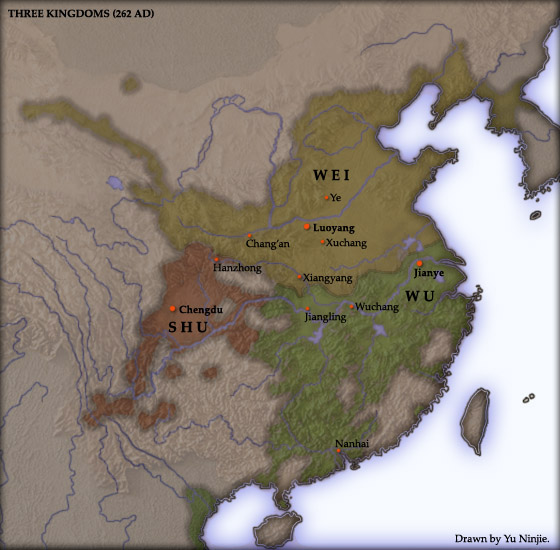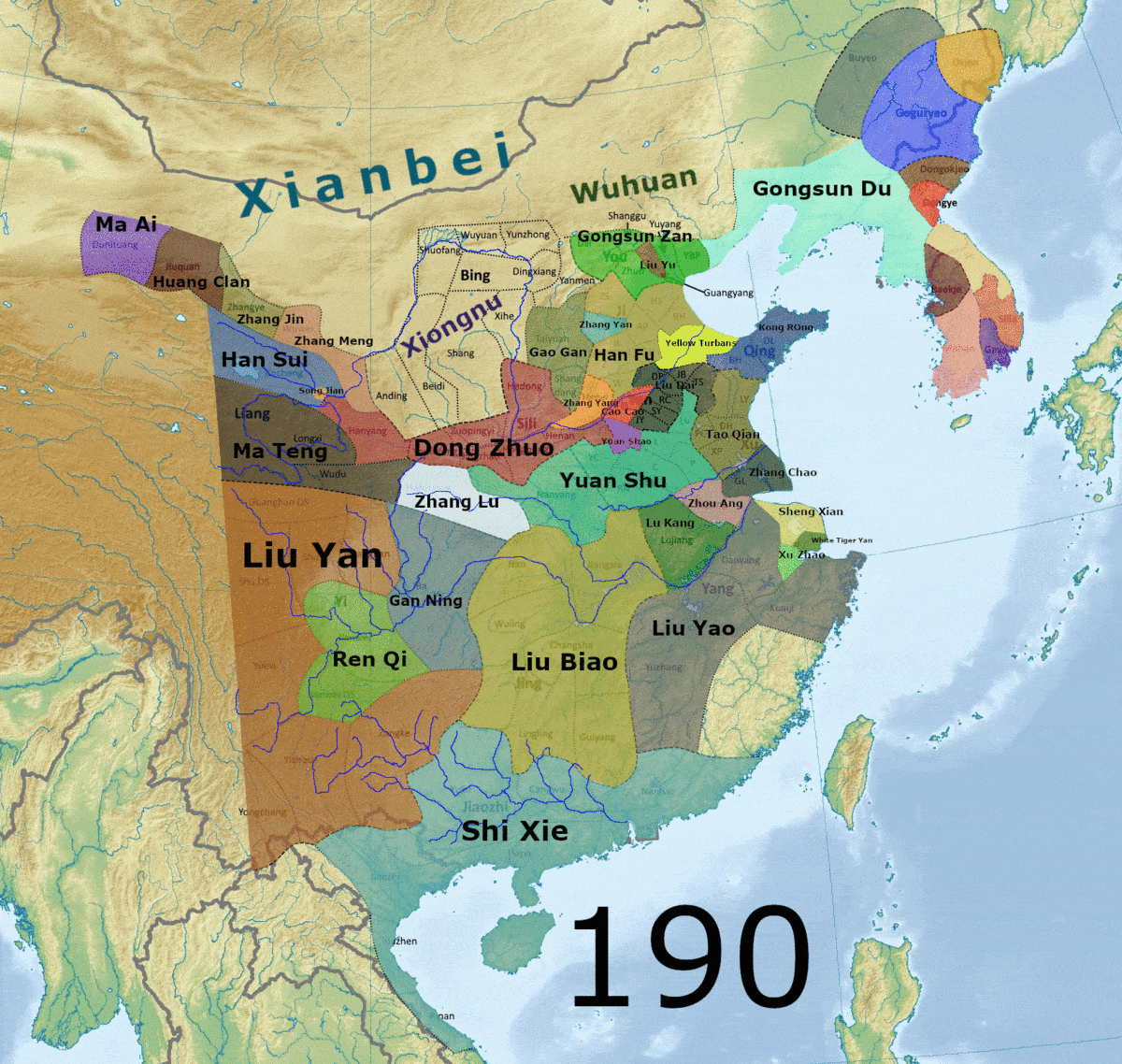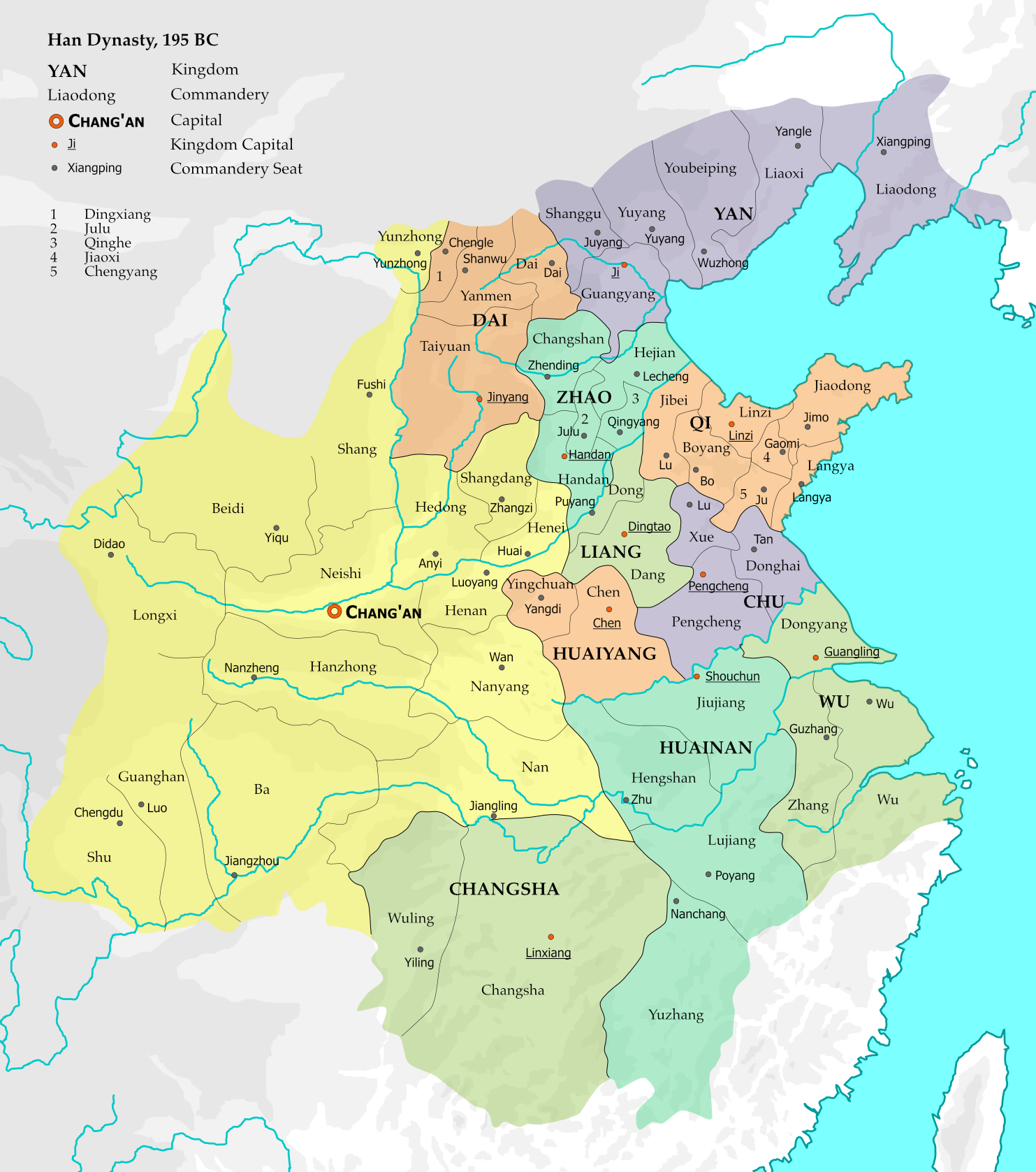|
Conquest Of Shu By Wei
The Conquest of Shu by Wei was a military campaign launched by the dynastic state of Cao Wei against its rival Shu Han in late 263 during the Three Kingdoms period of China. The campaign culminated in the fall of Shu Han and the tripartite equilibrium maintained in China proper for over 40 years since the End of the Han dynasty, end of the Han dynasty#Eastern Han, Eastern Han dynasty in 220. The conquest laid the foundation for an eventual reunified China proper under the Jin dynasty (266–420)#Western Jin (266–316), Western Jin dynasty in 280. Background Following the End of the Han dynasty, end of the Eastern Han dynasty in 220, three contending states emerged in China and fought for control over the territories of the former Han Empire. Among the three, Cao Wei, Wei was the most powerful one in terms of military prowess, economic resources, manpower and geographical size. The other two, Shu Han, Shu and Eastern Wu, Wu, reestablished their alliance against Wei in 223. Be ... [...More Info...] [...Related Items...] OR: [Wikipedia] [Google] [Baidu] |
Three Kingdoms
The Three Kingdoms () from 220 to 280 AD was the tripartite division of China among the dynastic states of Cao Wei, Shu Han, and Eastern Wu. The Three Kingdoms period was preceded by the Han dynasty#Eastern Han, Eastern Han dynasty and was followed by the Jin dynasty (266–420), Western Jin dynasty. The short-lived state of Yan (Three Kingdoms), Yan on the Liaodong Peninsula, which lasted from 237 to 238, is sometimes considered as a "4th kingdom". Academically, the period of the Three Kingdoms refers to the period between the establishment of Cao Wei in 220 and the Conquest of Wu by Jin, conquest of the Eastern Wu by the Western Jin in 280. The earlier, "unofficial" part of the period, from 184 to 220, was marked by chaotic infighting between warlords in various parts of China during the end of the Han dynasty, downfall of the Eastern Han dynasty. The middle part of the period, from 220 to 263, was marked by a more militarily stable arrangement between three rival states ... [...More Info...] [...Related Items...] OR: [Wikipedia] [Google] [Baidu] |
End Of The Han Dynasty
The end of the Han dynasty was the period of Chinese history from 189 to 220 CE, roughly coinciding with the tumultuous reign of the Han dynasty's last ruler, Emperor Xian. During this period, the country was thrown into turmoil by the Yellow Turban Rebellion (184–205). Meanwhile, the Han Empire's institutions were destroyed by the warlord Dong Zhuo and fractured into regional regimes ruled by various warlords, some of whom were nobles and officials of the Han imperial court. One of those warlords, Cao Cao, was gradually reunifying the empire, ostensibly under Emperor Xian's rule; the Emperor and his court were actually controlled by Cao Cao himself, who was opposed by other warlords. Cao Cao's efforts to completely reunite the land were rebuffed at the Battle of Red Cliffs in 208 / 209 when his armies were defeated by the allied forces of Sun Quan and Liu Bei. The Han dynasty formally ended in 220 when Cao Cao's son and heir, Cao Pi, pressured Emperor Xian into abdicating i ... [...More Info...] [...Related Items...] OR: [Wikipedia] [Google] [Baidu] |
Sima Yi
Sima Yi ( ; 179 CE – 7 September 251 CE), courtesy name Zhongda, was a Chinese military general, politician, and regent of the state of Cao Wei during the Three Kingdoms period of China. He formally began his political career in 208 under the Han dynasty's Imperial Chancellor Cao Cao, and was quickly promoted to higher office. His success in handling domestic and military affairs such as governance and the promotion of agriculture, serving as an adviser, repelling incursions and invasions led by Shu and Wu forces, speedily defeating Meng Da's Xincheng Rebellion, and conquering the Gongsun-led Liaodong commandery, garnered him great prestige. He is perhaps best known for defending Wei from a series of invasions that were led by Wei's rival state Shu between 231 and 234. In 239, along with another co-regent Cao Shuang, he was made to preside as a regent for the young Cao Fang after the death of latter's adoptive father, Cao Rui. Although amicable at first, the ... [...More Info...] [...Related Items...] OR: [Wikipedia] [Google] [Baidu] |
Jiang Wei's Northern Expeditions
Jiang Wei's Northern Expeditions refer to a series of eleven military campaigns launched by the state of Shu Han against its rival state, Cao Wei, between 240 and 262 CE during the Three Kingdoms period in China. The campaigns were led by Jiang Wei, a prominent Shu general. Unlike the previous Northern campaigns led by Zhuge Liang, which added Wudu and Yinping commanderies to Shu Han state territories, Jiang Wei's campaigns ended up being unpopular in both the military and civil circles in Shu. Also unlike Zhuge Liang's campaigns which often featured 60,000 to sometimes even 100,000 Shu Troops, Jiang Wei's were often much smaller rarely exceeding 30,000 even after the death of Fei Yi, where Jiang Wei assumed control of the military. The Zhuge Liang campaigns did suffer from logistical and supply issues for their large army. Zhuge's successor Jiang Wan, believed that it was the Hanzhong's mountainous terrain itself that were to blame for the campaigns failures and attempted t ... [...More Info...] [...Related Items...] OR: [Wikipedia] [Google] [Baidu] |
Fei Yi
Fei Yi (died 16 February 253), courtesy name Wenwei, was a regent and military general of the state of Shu during the Three Kingdoms period of China. Born in the late Eastern Han dynasty, Fei Yi started his career as an attendant to Liu Shan, the eldest son and heir apparent of Liu Bei, a warlord who became the founding emperor of Shu. After Liu Shan became emperor in 223, Fei Yi gradually rose to prominence under the regency of Zhuge Liang, the Imperial Chancellor of Shu. During this time, he concurrently served as a military adviser under Zhuge Liang and as Shu's ambassador to its ally state Wu. He also played a significant role in the conflict between the Shu general Wei Yan and Zhuge Liang's chief clerk Yang Yi. After Zhuge Liang's death in 234, Fei Yi served as a deputy to the new regent Jiang Wan and progressively assumed greater responsibilities as Jiang Wan gradually relinquished his powers due to poor health. In 244, Fei Yi led Shu forces to victory at the Battl ... [...More Info...] [...Related Items...] OR: [Wikipedia] [Google] [Baidu] |
Jiang Wan
Jiang Wan (180s - November or December 246), courtesy name Gongyan, was a regent and military general of the state of Shu during the Three Kingdoms period of China. Born in the late Eastern Han dynasty, Jiang Wan initially served as a scribe, county chief and county prefect under the warlord Liu Bei, who later became the founding emperor of Shu. After Liu Bei's son Liu Shan succeeded his father as emperor in 223, Jiang Wan gradually rose to prominence under the regency of Zhuge Liang, the Imperial Chancellor of Shu. Between 228 and 234, while Zhuge Liang was away leading Shu forces on the Northern Expeditions against Shu's rival state Wei, Jiang Wan took charge of internal affairs and provided logistical support to the Shu forces at the frontline. After Zhuge Liang's death in 234, Jiang Wan succeeded him as regent and did well in gaining the Shu people's confidence and leading them into a post-Zhuge Liang era. During this time, he considered that the land-based route through ... [...More Info...] [...Related Items...] OR: [Wikipedia] [Google] [Baidu] |
Liang Province
Liang Province or Liangzhou () was a province in the northwest of ancient China, in the approximate location of the modern-day province of Gansu. It was bordered in the east by Sili Province. History Establishment The province was first conquered by the Han Chinese in the 120s BCE during the Han–Xiongnu War, and settled in the decades thereafter. The Hexi Corridor served to connect China proper with the Western Regions, which helped secure important parts of the Silk Road into Central Asia. Qiang rebellions In 107 CE, the Xianlian Qiang rebelled against Han authority. After heavy fighting, and proposals to abandon Liang Province, this First Great Qiang Rebellion was quelled in 118. Efforts were made to resettle the province from 129 to 144, although large parts of Liang remained without effective government. General Duan Jiong conducted another successful campaign against Qiang rebels in 167–169, committing a massacre at Shoot-Tiger Valley. End of Han rule I ... [...More Info...] [...Related Items...] OR: [Wikipedia] [Google] [Baidu] |
Yong Province
Yong Province or Yongzhou was the name of various regions and provinces in ancient China, usually around the Wei River or the imperial capital. Geographical region In the ''Book of Documents'', Yongzhou is mentioned as one of the legendary Nine Provinces of China's prehistoric antiquity. From the Western Zhou dynasty to the Western Jin dynasty, the name Yongzhou was applied to the area around the imperial capital, whether it was the Wei Valley (also known as Guanzhong) or the territory around Luoyang. When Emperor Wu of the Western Han dynasty created the 13 inspectorates (刺史部; ), the western part of Yongzhou became part of Liangzhou Inspectorate (凉州刺史部) and its eastern part was governed by the Colonel-Director of Retainers (司隶校尉). Han province When Emperor Wu of Han relocated the Han capital to Luoyang, he briefly established a formal Yong Province. However, he abolished it soon after. Han inspectorate In AD194, the Eastern Han government ... [...More Info...] [...Related Items...] OR: [Wikipedia] [Google] [Baidu] |
Zhuge Liang's Northern Expeditions
Zhuge Liang's Northern Expeditions were a series of five military campaigns launched by the state of Shu Han against the rival state of Cao Wei from 228 to 234 during the Three Kingdoms period in China. All five expeditions were led by Zhuge Liang, the Imperial Chancellor and regent of Shu. Although they proved unsuccessful and ended up as a stalemate, the expeditions have become some of the best known conflicts of the Three Kingdoms period and one of the few battles during it where each side (Shu and Wei) fought against each other with hundreds of thousands of troops, as opposed to other battles where one side had a huge numerical advantage. The expeditions are dramatised and romanticised in the 14th-century historical novel '' Romance of the Three Kingdoms'', where they are referred to as the "six campaigns from Mount Qi" (). This term is inaccurate, since Zhuge Liang only launched two of his expeditions (the first and the fourth) from Mount Qi. Background In 220, follo ... [...More Info...] [...Related Items...] OR: [Wikipedia] [Google] [Baidu] |
Zhuge Liang
Zhuge Liang ( zh, t=諸葛亮 / 诸葛亮) (181 – September 234), courtesy name Kongming, was a Chinese statesman and military strategist. He was chancellor and later regent of the state of Shu Han during the Three Kingdoms period. He is recognised as the most accomplished strategist of his era, and has been compared to Sun Tzu, the author of ''The Art of War''. His reputation as an intelligent and learned scholar grew even while he was living in relative seclusion, earning him the nickname "Wolong" or "Fulong", meaning "Crouching Dragon" or "Sleeping Dragon". Zhuge Liang is often depicted wearing a Taoist robe and holding a hand fan made of crane feathers. Zhuge Liang was a Confucian-oriented "Legalist". He liked to compare himself to the sage minister Guan Zhong and Yue Yi developing Shu's agriculture and industry to become a regional power, and attached great importance to the works of Shen Buhai and Han Fei, refusing to indulge local elites and adopting strict, ... [...More Info...] [...Related Items...] OR: [Wikipedia] [Google] [Baidu] |
Eastern Wu
Wu ( Chinese: 吳; pinyin: ''Wú''; Middle Chinese *''ŋuo'' < Eastern Han Chinese: ''*ŋuɑ''), known in historiography as Eastern Wu or Sun Wu, was one of the three major states that competed for supremacy over in the Three Kingdoms period (220–280). It previously existed from 220–222 as a vassal kingdom nominally under Cao Wei, its rival state, but declared independence from Wei and became a sovereign state in 222. It became an empire in 229 after its founding ruler, |
Eastern Han Dynasty
The Han dynasty (, ; ) was an imperial dynasty of China (202 BC – 9 AD, 25–220 AD), established by Liu Bang (Emperor Gao) and ruled by the House of Liu. The dynasty was preceded by the short-lived Qin dynasty (221–207 BC) and a warring interregnum known as the ChuHan contention (206–202 BC), and it was succeeded by the Three Kingdoms period (220–280 AD). The dynasty was briefly interrupted by the Xin dynasty (9–23 AD) established by usurping regent Wang Mang, and is thus separated into two periods—the Western Han (202 BC – 9 AD) and the Eastern Han (25–220 AD). Spanning over four centuries, the Han dynasty is considered a golden age in Chinese history, and it has influenced the identity of the Chinese civilization ever since. Modern China's majority ethnic group refers to themselves as the " Han people", the Sinitic language is known as "Han language", and the written Chinese is referred to as " Han characters". The emperor was at the p ... [...More Info...] [...Related Items...] OR: [Wikipedia] [Google] [Baidu] |






.jpg)

